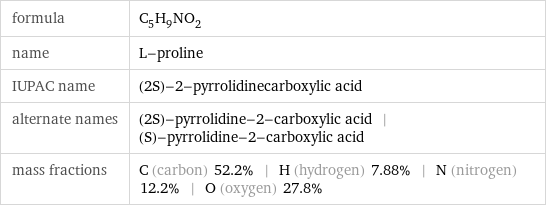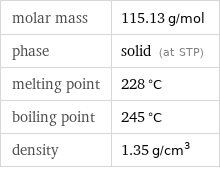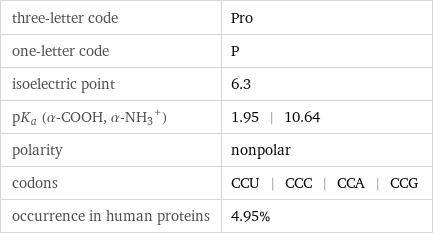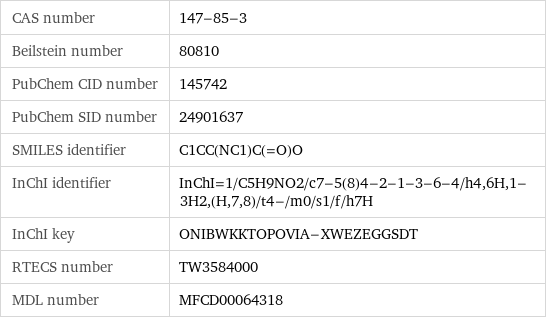Input interpretation

L-proline
Chemical names and formulas

formula | C_5H_9NO_2 name | L-proline IUPAC name | (2S)-2-pyrrolidinecarboxylic acid alternate names | (2S)-pyrrolidine-2-carboxylic acid | (S)-pyrrolidine-2-carboxylic acid mass fractions | C (carbon) 52.2% | H (hydrogen) 7.88% | N (nitrogen) 12.2% | O (oxygen) 27.8%
Lewis structure

Draw the Lewis structure of L-proline. Start by drawing the overall structure of the molecule, ignoring potential double and triple bonds: Count the total valence electrons of the carbon (n_C, val = 4), hydrogen (n_H, val = 1), nitrogen (n_N, val = 5), and oxygen (n_O, val = 6) atoms: 5 n_C, val + 9 n_H, val + n_N, val + 2 n_O, val = 46 Calculate the number of electrons needed to completely fill the valence shells for carbon (n_C, full = 8), hydrogen (n_H, full = 2), nitrogen (n_N, full = 8), and oxygen (n_O, full = 8): 5 n_C, full + 9 n_H, full + n_N, full + 2 n_O, full = 82 Subtracting these two numbers shows that 82 - 46 = 36 bonding electrons are needed. Each bond has two electrons, so in addition to the 17 bonds already present in the diagram add 1 bond. To minimize formal charge oxygen wants 2 bonds and carbon wants 4 bonds. Identify the atoms that want additional bonds and the number of electrons remaining on each atom: Fill in the 1 bond by pairing electrons between adjacent highlighted atoms: Answer: | |
3D structure

3D structure
Basic properties

molar mass | 115.13 g/mol phase | solid (at STP) melting point | 228 °C boiling point | 245 °C density | 1.35 g/cm^3
Units

Hydrophobicity and permeability properties

experimental LogP hydrophobicity | -2.4 predicted LogP hydrophobicity | -2.7 predicted LogS | 0.5
Basic drug properties

approval status | approved | nutraceutical | small molecule drug categories | dietary supplement | micronutrient | non-essential amino acid
Amino acid properties

three-letter code | Pro one-letter code | P isoelectric point | 6.3 pK_a (α-COOH, (α-NH_3)^+) | 1.95 | 10.64 polarity | nonpolar codons | CCU | CCC | CCA | CCG occurrence in human proteins | 4.95%
Solid properties (at STP)

density | 1.35 g/cm^3 vapor pressure | 0.006 mmHg (at 25 °C)
Units

Chemical identifiers

CAS number | 147-85-3 Beilstein number | 80810 PubChem CID number | 145742 PubChem SID number | 24901637 SMILES identifier | C1CC(NC1)C(=O)O InChI identifier | InChI=1/C5H9NO2/c7-5(8)4-2-1-3-6-4/h4, 6H, 1-3H2, (H, 7, 8)/t4-/m0/s1/f/h7H InChI key | ONIBWKKTOPOVIA-XWEZEGGSDT RTECS number | TW3584000 MDL number | MFCD00064318
Safety properties

flash point | 106 °C